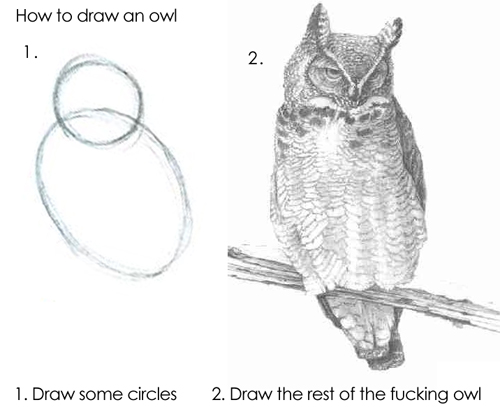Draw the rest of the owl

This image is often used to illustrate how hard it can be to go from simple examples to the real thing you actually want.
I recently needed to draw a f*cking owl in R, so I decided to record the process as an experiment.
When I teach STAT545 or Software Carpentry, I try to convey as much about process as anything else. You can always look up technical details, e.g., syntax, but you don’t usually get to see how other people work. This is also how I approach teaching about writing R functions. Newcomers often look at finished code and assume it flowed perfectly formed out of someone’s fingertips. It probably did not.
My modus operandi: start with something that works and add features in small increments, maniacally checking that everything still works. Other people undoubtedly move faster (and, therefore, travel faster but crash harder), but I’m OK with that.
Context: writing a function factory
I have an R package googlesheets that gets Google Sheets in and out of R. Lately we’ve had alot of trouble with Internal Server Error (HTTP 500), which, as you might expect, is an error on the Google server side. All you can do as a user is try, try again. But this is a showstopper for unattended scripts or multi-step operations, like building and checking the package. A single error renders lots of other work moot, which is completely infuriating.
I want to catch these errors and automatically retry the request after an appropriate delay.
The brute force approach would be to literally drop little for or while loops all over the package, to inspect the response and retry if necessary. But I try to follow the DRY principle, so would prefer to write a new “retry-capable” version of the function that makes these http requests.
It also turns out there’s more than one function for making these requests. I’m talking about the HTTP verbs you use with REST APIs: GET, POST, PATCH, etc. I potentially need to give them all the “retry” treatment. So what I really need is a function factory: an HTTP verb goes in and out comes a retry-capable version of the verb.
It turns out you can write R (or S) for ~20 years and not be very facile with this technique. I certainly am not! But I can read, which is how I got the two circles to start my owl.
Start at the beginning
My reference is the section of Wickham’s Advanced R that is about closures, “functions written by functions”. Here’s one of the two main examples: a function that creates an exponentiation function.
power <- function(exponent) {
function(x) {
x ^ exponent
}
}
square <- power(2)
square(2)
## [1] 4
square(4)
## [1] 16
cube <- power(3)
cube(2)
## [1] 8
cube(4)
## [1] 64I make myself type all this code in and run it. No shortcuts!
What have I learned? I can write a factory, power(), that takes some input, exponent, and gives me back a function, such as square() or cube().
But let’s be honest, this is pretty far from what I need to do.
Can the input be a function?
My problem is different. My input is a function, not an exponent like 2 or 3. Can I even do that?
The simplest thing I could think of that sort of looks like my problem:
- the factory takes a function as input
- it returns a function that executes the input function twice, with whatever inputs that function had in the first place
call_me_twice <- function(f) {
function(...) {
f(...)
f(...)
}
}Now I need an input function to be the guinea pig. It needs to take input and be chatty, so I can tell if it’s getting executed. Make sure it works as expected!
jfun <- function(x) cat(x, "\n")
jfun("a")
## a
jfun(1)
## 1Put it all together.
jfunner <- call_me_twice(jfun)
jfunner("a")
## a
## a
jfunner(1)
## 1
## 1I won’t lie, I’m pleasantly surprised this worked. Morale boost.
Faux VERB
I need a placeholder for the HTTP verbs with these qualities:
- takes some input
- generates a non-deterministic status
- returns a list with the input, status, and some content
VERB <- function(url = "URL!")
list(url = url,
status = sample(c(200, 500), size = 1, prob = c(0.6, 0.4)),
content = rnorm(5))
VERB()
## $url
## [1] "URL!"
##
## $status
## [1] 500
##
## $content
## [1] 0.7725060 0.9217522 2.2873838 0.6078766 -0.2556910
VERB()
## $url
## [1] "URL!"
##
## $status
## [1] 200
##
## $content
## [1] -1.6951869 0.1556852 0.9170427 1.2368064 0.1631589Oh wait, we have functions in R to do something over and over again.
replicate(5, VERB())
## [,1] [,2] [,3] [,4] [,5]
## url "URL!" "URL!" "URL!" "URL!" "URL!"
## status 200 200 500 500 200
## content Numeric,5 Numeric,5 Numeric,5 Numeric,5 Numeric,5Send VERB() off to the function factory.
VERB_twice <- call_me_twice(VERB)
replicate(5, VERB_twice())
## [,1] [,2] [,3] [,4] [,5]
## url "URL!" "URL!" "URL!" "URL!" "URL!"
## status 500 200 200 200 200
## content Numeric,5 Numeric,5 Numeric,5 Numeric,5 Numeric,5Hmmmm … I only see one output per call of VERB_twice(). But why? Is it because VERB() is only getting called once? That means I’ve screwed up. Or is VERB() getting called twice but I’m only seeing evidence of the second call?
A better faux VERB
VERB <- function(url = "URL!") {
req <- list(url = url,
status = sample(c(200, 500), size = 1, prob = c(0.6, 0.4)),
content = rnorm(5))
message(req$status)
req
}
replicate(5, VERB())
## 200
## 200
## 500
## 200
## 200
## [,1] [,2] [,3] [,4] [,5]
## url "URL!" "URL!" "URL!" "URL!" "URL!"
## status 200 200 500 200 200
## content Numeric,5 Numeric,5 Numeric,5 Numeric,5 Numeric,5Why is this better? Each call of VERB() causes a message AND returns something.
Send new and improved VERB() off to the function factory.
VERB_twice <- call_me_twice(VERB)
replicate(5, VERB_twice())
## 200
## 200
## 500
## 200
## 200
## 200
## 200
## 200
## 200
## 200
## [,1] [,2] [,3] [,4] [,5]
## url "URL!" "URL!" "URL!" "URL!" "URL!"
## status 200 200 200 200 200
## content Numeric,5 Numeric,5 Numeric,5 Numeric,5 Numeric,5I like it! What do I like about it?
- 5 calls produce 10 messages, which tells me
VERB()is getting called twice. - 5 calls produce 5 outputs, which is good for my eventual goal, where I will only want to return the value of the last call of the enclosed function.
Retry n times … and a temporary setback
Instead of hard-wiring 2 calls of the enclosed function f, let’s call it n times via a for loop.
call_me_n <- function(f, n = 3) {
function(...) for (i in seq_len(n)) f(...)
}Let’s try my new function factory.
VERB_3 <- call_me_n(VERB)
VERB_3()
## 500
## 200
## 200That’s disappointing. I see the message, but get no actual output. Is there really no output coming back? Or is it just invisible?
x <- VERB_3()
## 200
## 500
## 200
str(x)
## NULLNope, there really is no output. Fix that.
call_me_n <- function(f, n = 3) {
function(...) {
for (i in seq_len(n)) out <- f(...)
out
}
}
VERB_3 <- call_me_n(VERB)
VERB_3()
## 200
## 500
## 200
## $url
## [1] "URL!"
##
## $status
## [1] 200
##
## $content
## [1] -1.39305501 -1.12975777 -2.63549110 0.70291225 -0.05617746YAY! Before I move on, let’s make sure I can actually set the n argument to something other than 3.
VERB_4 <- call_me_n(VERB, 4)
VERB_4()
## 200
## 200
## 200
## 200
## $url
## [1] "URL!"
##
## $status
## [1] 200
##
## $content
## [1] 1.47958363 -0.02104596 0.47492109 0.64907758 -1.09196531Conditional retries
Almost done!
My real factory needs to use the output of the enclosed HTTP verb to decide whether a retry is sensible. The new name reflects HTTP verb specificity. I now add the actual logic and behavior I need in real life.
VERB_n <- function(VERB, n = 3) {
force(VERB)
force(n)
function(...) {
for (i in seq_len(n)) {
out <- VERB(...)
if (out$status < 499 || i == n) break
backoff <- runif(n = 1, min = 0, max = 2 ^ i - 1)
message("HTTP error ", out$status, " on attempt ", i,
" ... retrying after a back off of ", round(backoff, 2),
" seconds.")
Sys.sleep(backoff)
}
out
}
}I send my existing faux VERB() off to the new and improved factory. Start providing input again, just to make sure that all still works.
VERB_5 <- VERB_n(VERB, n = 5)
VERB_5("Owls can rotate their necks 270 degrees.")
## 200
## $url
## [1] "Owls can rotate their necks 270 degrees."
##
## $status
## [1] 200
##
## $content
## [1] 1.3812422 -1.8105817 -0.3256026 -0.4936094 -1.7317095
VERB_5("Owls are cute.")
## 200
## $url
## [1] "Owls are cute."
##
## $status
## [1] 200
##
## $content
## [1] 0.3651856 -0.2583526 0.5737657 -0.6806672 0.3468226
VERB_5("A group of owls is called a Parliament.")
## 500
## HTTP error 500 on attempt 1 ... retrying after a back off of 0.91 seconds.
## 500
## HTTP error 500 on attempt 2 ... retrying after a back off of 0.92 seconds.
## 500
## HTTP error 500 on attempt 3 ... retrying after a back off of 5.66 seconds.
## 200
## $url
## [1] "A group of owls is called a Parliament."
##
## $status
## [1] 200
##
## $content
## [1] -1.11905405 -2.30975730 0.50613962 -0.02815278 0.37802033And we have drawn some f*cking owls, with retries!

The final result is not that exciting
Now in real life, I create retry-capable HTTP verbs like so: rGET <- VERB_n(httr::GET). Then just replace all instances of httr::GET() with rGet(). It’s terribly anticlimactic.
The final version of the function factory is about a dozen lines of fairly pedestrian code. I probably wrote and discarded at least 10x that. This is typical, so don’t be surprised if this is how it works for you too. Get a working example and take tiny steps to morph it into the thing you need.
The results of this effort are, however, pretty gratifying. I have had zero build/check failures locally and on Travis, since I implemented retries on httr::GET(). Or, to be honest, I’ve had failures, but for other reasons. So it was totally worth it! I also thank Konrad Rudolph and Kevin Ushey for straightening me out on the need to use force() inside the function factory.
